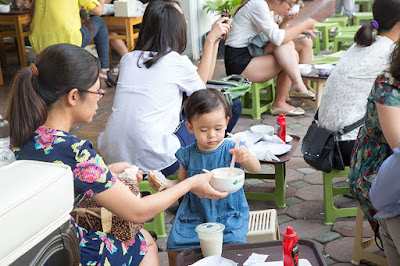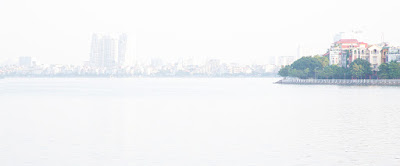I swam in a dam in Vietnam...
Was the water clean?? I have no idea, but what fun, and in that heat it was bliss. Two young Israelis went with us, but were very sceptical about getting in. But when they saw me doing it, I think they were ashamed of being scared, and followed. But they did not venture close to the wall, sissies...
My son took me to Mai Chau . We went by bus, a 4 hour bus ride. When we got there, he booked into a homestay in the village for one night. It is in the middle of rice fields, very beautiful surroundings.
Fortunately we were the only two in the room. All open, with mosquito nets. The bathrooms were very clean, if primitive. How nice to sleep so open, no door, nothing. It cooled down with a little breeze as the sun went down.
We went for a walk and saw the village preparing for a wedding. The venue was decorated:
The chickens of the East are quite unusual, not much body and long legs. Of course they love the legs and feet.
So the food for the wedding came to the venue:
This is how they are sold on the market!
Quite a large house in the village:
For the next night we took a taxi to another homestay out in the farming area called Minh To. Because there was a school group also staying there, we got a separate room:
It was over a dam, so the mosquitos attacked us! Thank you for nets over the bed.
The food was excellent:
We went for lovely walks in the farming area.
This friendly woman's teeth were rotten because of the betel nut some of them constantly chews.
It has many harmful effects on their health and is carcnogenic to humans, often resulting in oral cancer.
Usually for chewing, a few slices of the nut are wrapped in a betel leaf along with slaked lime and some spices, cardemom, cloves etc. (Wikipedia)
Farming in Vietnam is mainly done by hand and animals. The small spaces between the mountains does not allow for tractors etc.
Rice was being harvested when we were there.
Being cut:
Since a large portion of maize crops are grown for purposes other than for humans, rice is the most important grain for human nutrition, providing more than one-fifth of calories consumed worldwide by humans.
Wild rice, from which the crop was developed, may have come from Australia. Domestication took place first in the Pearl River valley region of Ancient China 8,200 -13,500 years ago. It comes in many different colours and sizes.
(Wikipedia)
Here the rice is being taken off the stalks and then bagged in the little village we stayed in.
two pretty little faces:
I love Vietnam. it is still untouched in a way, unspoiled.
Another memory made. These memories with my son will have to last me another year!
Bye.




































































